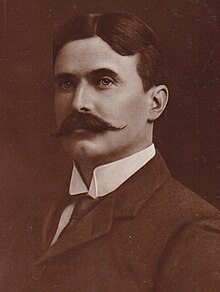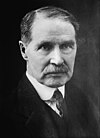William Peel, 1st Earl Peel
The Earl Peel | |
|---|---|
 Peel in 1910 | |
| Lord Keeper of the Privy Seal | |
| In office 3 September 1931 – 5 November 1931 | |
| Monarch | George V |
| Prime Minister | Ramsay MacDonald |
| Preceded by | Tom Johnston |
| Succeeded by | The Viscount Snowden |
| Secretary of State for India | |
| In office 18 October 1928 – 4 June 1929 | |
| Monarch | George V |
| Prime Minister | Stanley Baldwin |
| Preceded by | The Earl of Birkenhead |
| Succeeded by | William Wedgwood Benn |
| In office 19 March 1922 – 22 January 1924 | |
| Monarch | George V |
| Prime Minister | David Lloyd George Bonar Law Stanley Baldwin |
| Preceded by | Edwin Montagu |
| Succeeded by | The Lord Olivier |
| First Commissioner of Works | |
| In office 10 November 1924 – 18 October 1928 | |
| Monarch | George V |
| Prime Minister | Stanley Baldwin |
| Preceded by | Fred Jowett |
| Succeeded by | The Marquess of Londonderry |
| Minister of Transport | |
| In office 7 November 1921 – 12 April 1922 | |
| Monarch | George V |
| Prime Minister | David Lloyd George |
| Preceded by | Eric Geddes |
| Succeeded by | The Earl of Crawford |
| Chancellor of the Duchy of Lancaster | |
| In office 1 April 1921 – 19 March 1922 | |
| Monarch | George V |
| Prime Minister | David Lloyd George |
| Preceded by | The Earl of Crawford |
| Succeeded by | William Sutherland |
| Parliamentary Under-Secretary of State for War | |
| In office 10 January 1919 – 1 April 1921 | |
| Monarch | George V |
| Prime Minister | David Lloyd George |
| Preceded by | Ian Macpherson |
| Succeeded by | Robert Sanders |
| Parliamentary Secretary to the Ministry of National Service | |
| In office 15 April 1918 – 10 January 1919 | |
| Monarch | George V |
| Prime Minister | David Lloyd George |
| Preceded by | Cecil Beck |
| Succeeded by | Position abolished |
| Member of the House of Lords Lord Temporal | |
| In office 24 October 1912 – 28 September 1937 as ahereditary peer | |
| Preceded by | The 1st Viscount Peel |
| Succeeded by | The 2nd Earl Peel |
| Member of Parliament forTaunton | |
| In office 23 February 1909 – 24 October 1912 | |
| Preceded by | Sir Edward Boyle |
| Succeeded by | Gilbert Wills |
| Member of Parliament forManchester South | |
| In office 29 May 1900 – 8 February 1906 | |
| Preceded by | John Campbell |
| Succeeded by | Arthur Haworth |
| Personal details | |
| Born | 7 January 1867 London |
| Died | 28 September 1937(aged 70) East Meon,nearPetersfield,Hampshire |
| Nationality | British |
| Political party | Liberal Unionist Conservative |
| Spouse | Hon. Eleanor Williamson |
| Children |
|
| Parent |
|
| Alma mater | Balliol College, Oxford |
William Robert Wellesley Peel, 1st Earl Peel,GCSI,GBE,TD,PC,DL(7 January 1867 – 28 September 1937), 2ndViscount Peelfrom 1912 to 1929, was a British politician who was a local councillor, aMember of Parliamentand a member of theHouse of Lords.After an early career as abarristerand ajournalist,he entered first local and then national politics. He rose to hold a number of ministerial positions but is probably best remembered for chairing thePeel Commissionin 1936–1937, which recommended for the first time the partition of theBritish Mandate of Palestineinto separate Jewish and Arab states.[1]
The grandson of a Conservative prime minister, he was unusual even for his period in the number of political parties for which he was elected. He began as a member of the Moderate Party on theLondon County Counciland later became the leader of the renamedMunicipal Reform Party;he was then elected as an MP for theLiberal Unionistsand then for theConservative Partybefore he inherited his seat in the Lords in 1912. He also served as a minister in governments led by Liberal, Conservative and Labour prime ministers.
His ministerial career began asUnder-Secretary of State for Warin 1919, and he entered the cabinet in 1922 asSecretary of State for Indiaand held a number of other ministerial positions.[1]
Early life and career
[edit]The eldest son ofArthur Peel, 1st Viscount Peel,and Adelaide Dugdale, William Peel was born inLondonin 1867. His father was the fifth and youngest son of Prime MinisterSir Robert Peel.[1]
Peel was educated atHarrowandBalliol College, Oxford,[2]where he was secretary of theOxford Union.[1]
In 1893, he wascalled to the barat theInner Templeand practised as abarristerbefore taking the position of special correspondent for theDaily Telegraphduring theGreco-Turkish War of 1897.[2][1]
Political career
[edit]In 1900, Peel was appointed a member of theRoyal Commissionthat was formed to inquire into the operation of thePort of London.In February the same year, he began his political career when he was elected in aby-electionto fill a vacant seat forWoolwichin theLondon County Council[3]to which he was re-elected in the ordinary election the following year. He was a member of the Moderate pro-Conservative grouping on the council that became theMunicipal Reform Party.He was leader of the party from 1908 to 1910 and chairman of the county council from 1914 to 1916.[2][1]

He began his parliamentary career when he was elected asLiberal UnionistMP forManchester Southat the1900 Manchester South by-election.At thenext general election in 1906,he stood unsuccessfully atHarrow.He returned to theCommonsin 1909, when he was elected asConservativeMP forTauntonat a by-election.[1]He inherited his father's viscountcy in 1912 and so moved to theHouse of Lords.
Peel was appointed adeputy lieutenantofBedfordshire[4]andlieutenant-colonelof theBedfordshire Yeomanryin 1912 and, at the outbreak of theFirst World Warmoved to France with his regiment, but ill health made him return to Britain in 1915. In 1918, he received his first government post as Joint Parliamentary Secretary at the Department of National Service in the coalition government ofDavid Lloyd George.In 1919, Peel becameUnder-Secretary of State for Warand a member of thePrivy Council.[2][1]Two years later, he becameChancellor of the Duchy of LancasterandMinister for Transport.
He entered the cabinet in 1922 asSecretary of State for India,and, after the downfall of Lloyd George's coalition, continued to hold the post during the premierships ofAndrew Bonar LawandStanley Baldwin.The latter's government fell in January 1924, but after a brief spell in opposition, it was returned to power at the1924 general election.Peel was appointedFirst Commissioner of Worksin the Conservative administration formed by Baldwin. In 1928, Peel briefly returned to the India Office, but the Conservatives lost power by the1929 general election.[1]
In 1929, Peel was createdViscount Clanfield,of Clanfield in the County of Southampton, andEarl Peelinthat year's Dissolution Honours.[2]When a Conservative-dominatedNational Governmentwas formed after the1931 election,he becameLord Privy Sealbut held that office for only two months and left government in November.[1]
In 1932, he was appointed chairman of the Wheat Commission, and in 1934, he chaired the Royal Commission on theCommon Law.In 1936–1937, he chaired thePeel Commission,which recommended for the first time the partition of theBritish Mandate of Palestineinto separate Jewish and Arab states.[1]
Family
[edit]Peel married in 1899 the Honourable Eleanor Williamson (1871–1949), daughter ofJames Williamson, 1st Baron Ashton.They had two children:
- Lady Doris Peel (1900[5]–1983), who married in 1927 Colonel Stewart Blacker (1887–1964), and had four children. She was aJustice of the Peacefor the County of London in 1939, and for Sussex in 1948.
- Arthur Peel, 2nd Earl Peel(1901–1969)
In 1929, Ashton died, and Peel succeeded him as chairman of James Williamson and Company. He was a director ofBarclays Bankand of theGreat Northern Railway.[2][1]
Death
[edit]Lord Peel died at 70 in his home inEast Meon,nearPetersfield,Hampshire,in 1937 after a long illness.[1][2]He was succeeded in his titles by his son,Arthur.
References
[edit]Leigh Rayment's Historical List of MPs
- ^abcdefghijklmAlex May (2004)."Peel, William Robert Wellesley, first Earl Peel (1867–1937)".Oxford Dictionary of National Biography(online ed.). Oxford University Press.doi:10.1093/ref:odnb/35453.Retrieved12 October2008.(Subscription orUK public library membershiprequired.)
- ^abcdefgLord Peel, Family Tradition Of Statesmanship,The Times, 30 September 1937, p. 14
- ^"London County Council election at Woolwich".The Times.No. 36075. London. 26 February 1900. p. 7.
- ^"No. 28638".The London Gazette.23 August 1912. p. 6288.
- ^"Births".The Times.No. 36100. London. 27 March 1900. p. 1.
External links
[edit]- 1867 births
- 1937 deaths
- People educated at Harrow School
- Military personnel from London
- British Army personnel of World War I
- Alumni of Balliol College, Oxford
- Earls in the Peerage of the United Kingdom
- Knights Grand Commander of the Order of the Star of India
- Knights Grand Cross of the Order of the British Empire
- Lords Privy Seal
- Members of London County Council
- Members of the Privy Council of the United Kingdom
- Liberal Unionist Party MPs for English constituencies
- UK MPs 1900–1906
- UK MPs 1906–1910
- UK MPs 1910
- UK MPs 1910–1918
- UK MPs who were granted peerages
- UK MPs who inherited peerages
- Deputy lieutenants of Bedfordshire
- Peel family
- People of the 1936–1939 Arab revolt in Palestine
- Bedfordshire Yeomanry officers
- Conservative Party (UK) MPs for English constituencies
- Members of the Parliament of the United Kingdom for Taunton
- Secretaries of State for Transport (UK)
- People from East Meon
- Peers created by George V
- Chancellors of the Duchy of Lancaster
- Viscounts Peel

